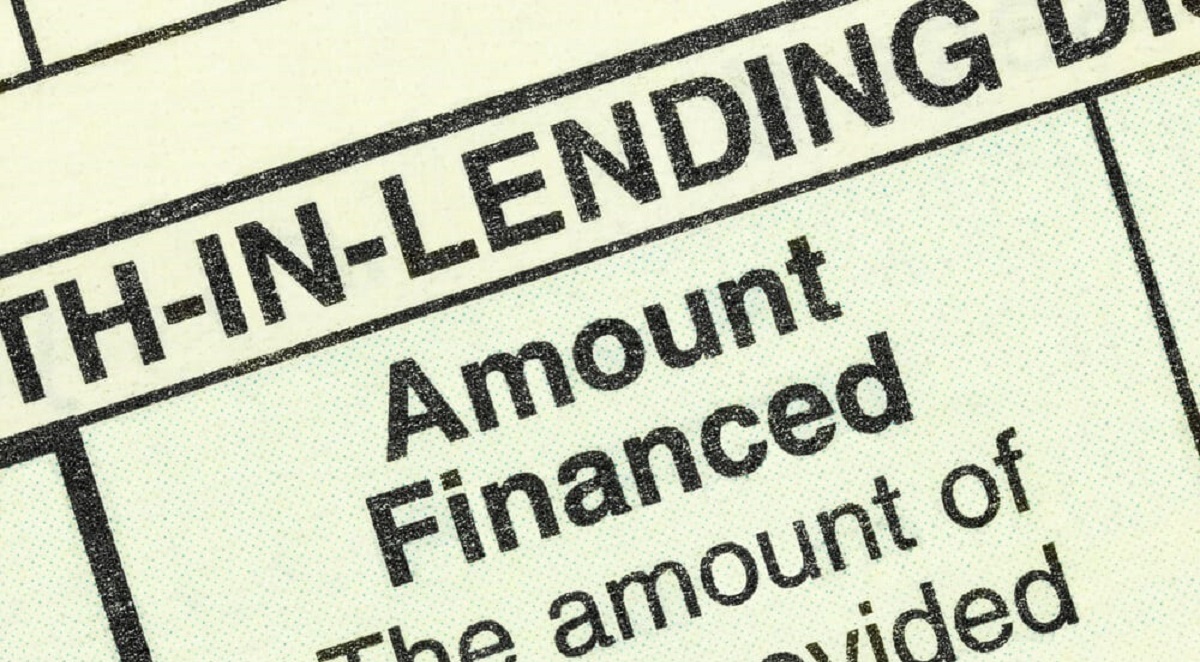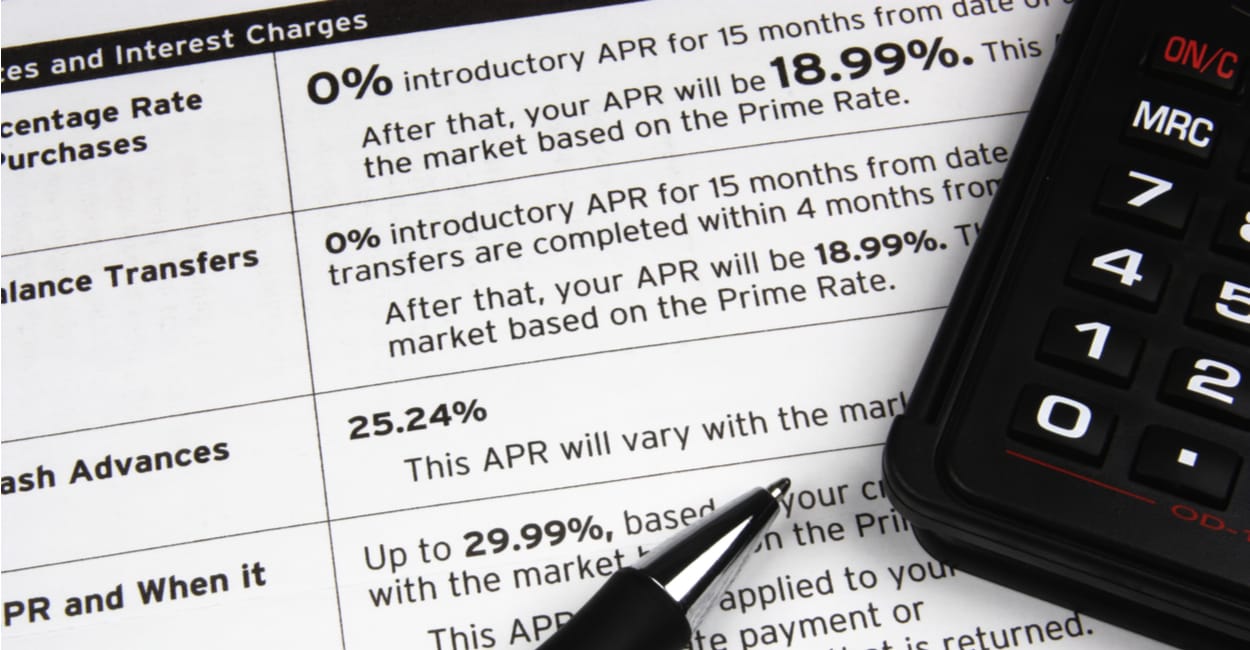Introduction
Welcome to our guide on how to calculate finance charges on Truth in Lending statements. If you’ve ever received a credit card statement or a loan agreement, you may have come across the term “finance charge.” Understanding what finance charges are and how they are calculated is essential for managing your finances effectively. In this article, we will provide a comprehensive overview of finance charges and walk you through the process of calculating them.
A finance charge is the fee that a lender charges a borrower for the use of credit. It is essentially the cost of borrowing money, expressed as a percentage of the loan amount or credit balance. Finance charges can be found in various types of loans, credit cards, mortgages, and other financial agreements.
When it comes to calculating finance charges, it’s important to note that different types of finance charges may apply depending on the terms and conditions specified in your loan agreement or credit card terms. These charges can include interest charges, fees, penalties, and other costs associated with borrowing the funds.
The calculation of finance charges can vary depending on factors such as the type of loan or credit account, the interest rate, and the billing cycle. To calculate finance charges accurately, it is crucial to understand the steps involved in the process.
In the following sections, we will walk you through the different types of finance charges you may encounter, the steps involved in calculating them, and provide examples to illustrate the calculations. We will also provide tips on how to minimize finance charges to help you save money in the long run.
So, whether you’re a borrower looking to understand the fees associated with your credit accounts or you simply want to expand your knowledge on finance charges, this guide will equip you with the knowledge and tools to make informed financial decisions.
Understanding Finance Charges
Before we dive into the process of calculating finance charges, it’s important to have a clear understanding of what finance charges are and how they can impact your overall financial obligations. A finance charge is essentially the cost of borrowing money, expressed as a percentage of the loan amount or credit balance.
Finance charges can include various components, such as interest charges, fees, penalties, and other costs associated with borrowing funds. These charges are typically disclosed in loan agreements, credit card terms, or Truth in Lending statements, allowing borrowers to understand the total cost of their borrowing.
Interest charges are the most common form of finance charges. Lenders charge interest as compensation for lending you money. The interest rate is typically expressed as an annual percentage rate (APR). This percentage reflects the cost of borrowing over a one-year period. However, depending on the terms of your loan or credit agreement, finance charges may be calculated on a different basis, such as monthly or daily.
In addition to interest charges, lenders may impose various fees and penalties as part of the finance charges. These can include application fees, annual fees, late payment fees, balance transfer fees, and cash advance fees. It’s important to carefully review the terms and conditions of your loan or credit agreement to understand all the potential charges you may incur.
Understanding finance charges is crucial for managing your finances effectively. By knowing the costs associated with borrowing money, you can make informed decisions about your credit accounts and budget accordingly. It’s important to note that finance charges can significantly impact the total amount you owe. Therefore, it’s essential to stay vigilant and be aware of how these charges are calculated.
In the next section, we will explore the different types of finance charges you may encounter and delve into the step-by-step process of calculating them. By gaining a comprehensive understanding of finance charges, you will be better equipped to assess the true cost of borrowing and make sound financial choices.
Types of Finance Charges
When it comes to finance charges, there are various types that you may encounter depending on the type of loan or credit account you have. Understanding these different types of charges will help you have a clearer picture of the costs associated with borrowing money. Here are some common types of finance charges:
- Interest Charges: This is the most common type of finance charge. Lenders charge interest as a percentage of the loan amount or credit balance. The interest rate can be fixed or variable and is typically based on the borrower’s creditworthiness and current market conditions.
- Annual Fee: Some credit cards come with an annual fee that is charged regardless of whether the card is used or not. This fee is an additional cost that you need to consider when calculating the finance charges on your credit card.
- Late Payment Fee: If you fail to make your loan payment or credit card payment by the due date, you may be charged a late payment fee. This fee can vary depending on the lender but is usually a flat amount or a percentage of the overdue payment.
- Balance Transfer Fee: When you transfer the outstanding balance from one credit card to another, you may be charged a balance transfer fee. This fee is typically a percentage of the transferred amount.
- Cash Advance Fee: If you use your credit card to obtain a cash advance, such as withdrawing cash from an ATM, you may be charged a cash advance fee. This fee is usually a flat amount or a percentage of the cash advance amount.
- Origination Fee: In some loan agreements, lenders may charge an origination fee. This fee is applied to cover the costs associated with processing and approving the loan.
- Prepayment Penalty: Some loans may come with a prepayment penalty if you decide to pay off the loan early. This penalty is intended to compensate the lender for the interest payments they will miss out on due to early repayment.
It’s important to carefully review the terms and conditions of your loan or credit agreement to understand all the potential finance charges you may encounter. By knowing the different types of finance charges, you can better assess the true cost of borrowing and factor them into your financial planning.
Now that we have a good understanding of the types of finance charges, let’s move on to the next section, where we will explore the step-by-step process of calculating finance charges.
Calculating Finance Charges
Calculating finance charges may seem daunting at first, but with a clear understanding of the steps involved, you can easily determine the total cost of borrowing. The calculation process involves several key factors, including the average daily balance, the annual percentage rate (APR), the periodic interest rate, and the billing cycle. Here’s a step-by-step guide on how to calculate finance charges:
Step 1: Determine the Average Daily Balance: The average daily balance is the average amount that you owe over a billing cycle. To calculate this, add up your daily balances for each day of the billing cycle and divide it by the number of days in the cycle.
Step 2: Find the Annual Percentage Rate (APR): The APR is the interest rate charged on an annual basis. It is crucial to ensure that you have the correct APR for accurate calculations. This information should be clearly stated in your loan agreement or credit card terms.
Step 3: Calculate the Periodic Interest Rate: The periodic interest rate is the interest rate charged for a specific period, such as monthly or daily. Convert the APR into the periodic interest rate using the appropriate formula provided in your loan agreement or credit card terms.
Step 4: Multiply the Average Daily Balance by the Periodic Interest Rate: Multiply the average daily balance by the periodic interest rate to determine the interest charge for each day of the billing cycle.
Step 5: Determine the Billing Cycle: The billing cycle is the period over which the finance charges are calculated. It starts from the first day to the last day of the cycle. The length of the billing cycle can vary depending on the lender.
Step 6: Calculate the Finance Charge: Multiply the daily interest rate (step 4) by the number of days in the billing cycle (step 5) to calculate the finance charge for that cycle. This is the amount that will be added to your outstanding balance.
It’s important to note that finance charges may also include fees or penalties, depending on the terms and conditions of your loan or credit agreement. Make sure to factor in these additional charges when calculating the total finance charge.
Now that we’ve covered the steps involved in calculating finance charges, let’s put them into practice with an example in the next section.
Step 1: Determine the Average Daily Balance
The average daily balance is a crucial factor in calculating finance charges accurately. This step helps determine the average amount that you owe over a billing cycle. To calculate the average daily balance, follow these steps:
- Obtain Daily Balances: Gather the daily balances for each day of the billing cycle. These balances are typically recorded in your loan statement or credit card statement.
- Add Daily Balances: Add up all the daily balances to get the total sum.
- Count the Number of Days: Determine the number of days in the billing cycle. The billing cycle can vary depending on the lender or credit card issuer.
- Calculate the Average: Divide the total sum of the daily balances by the number of days in the billing cycle. This will give you the average daily balance.
It’s important to note that the daily balances considered in this calculation include purchases, cash advances, and any other transaction that affects the outstanding balance. By determining the average daily balance accurately, you can have a more precise estimate of the finance charges you will incur.
For example, suppose you have a credit card with a billing cycle of 30 days and the daily balances over the course of the cycle are as follows:
- Day 1: $500
- Day 2: $600
- Day 3: $700
- Day 4: $800
- Day 5: $900
- Day 6: $1,000
To determine the average daily balance, add up the daily balances:
Total sum = $500 + $600 + $700 + $800 + $900 + $1,000 = $4,500
Next, count the number of days in the billing cycle, which is 6 in this example. Divide the total sum by the number of days:
Average daily balance = $4,500 / 6 = $750
The average daily balance in this scenario is $750. This amount will be used in the subsequent steps to calculate the finance charges accurately.
Now that we’ve determined the average daily balance, let’s move on to step 2, where we will explore how to find the annual percentage rate (APR).
Step 2: Find the Annual Percentage Rate (APR)
Finding the Annual Percentage Rate (APR) is an essential step in calculating finance charges accurately. The APR represents the annual interest rate charged on a loan or credit card balance. To find the APR, follow these steps:
- Review Loan Agreement or Credit Card Terms: Carefully review your loan agreement or credit card terms to locate the stated APR. This information is typically disclosed in the terms and conditions provided by the lender or credit card issuer.
- Ensure Correct APR: Confirm that the APR you are using for calculations matches the terms outlined in your loan agreement or credit card terms. Sometimes, there may be different APRs based on specific circumstances or introductory offers.
The APR is expressed as a percentage and serves as an important factor in determining the cost of borrowing. It includes the interest rate as well as any applicable fees or charges imposed by the lender. By understanding and verifying the APR, you can ensure that your finance charge calculations are accurate.
For example, let’s say you have a credit card with an APR of 18%. This means that for every $100 of outstanding balance on the card, you would be charged $18 in interest over the course of a year.
It’s important to note that the APR may vary depending on the type of loan or credit account. It may be a fixed rate or a variable rate that can fluctuate based on market conditions. Make sure to review your loan agreement or credit card terms to identify any specific details regarding the APR and how it is applied.
Now that we’ve found the APR, let’s move on to step 3, where we will calculate the periodic interest rate.
Step 3: Calculate the Periodic Interest Rate
Calculating the periodic interest rate is an important step in accurately determining finance charges. The periodic interest rate is the interest charged for a specific period, such as monthly or daily. To calculate the periodic interest rate, follow these steps:
- Obtain the Annual Percentage Rate (APR): Retrieve the APR from your loan agreement or credit card terms. The APR represents the interest rate charged annually.
- Determine the Period: Identify the period over which the interest is being calculated. This could be monthly, daily, or any other time frame specified in your loan agreement or credit card terms.
- Convert to Decimal: Divide the APR by the number of periods in a year. For example, if the APR is 18% and the interest is being calculated monthly, divide 18 by 12 to convert it to a monthly rate.
- Verify the Rate: Confirm that the calculated periodic interest rate aligns with the terms in your loan agreement or credit card terms. It should accurately represent the interest rate for the specified period.
By calculating the periodic interest rate, you can determine how much interest is charged for a specific time frame. This information is crucial for accurately estimating finance charges and understanding the cost of borrowing.
For example, let’s consider a loan with an APR of 12% interest charged annually, and we want to determine the monthly interest rate. To calculate the periodic interest rate, divide the APR by the number of periods in a year:
Monthly interest rate = 12% / 12 months = 1% (or 0.01)
The resulting periodic interest rate is 1% or 0.01 as a decimal. This means that for every $100 of outstanding balance, you would be charged $1 in interest per month.
Ensure that you understand the terms and conditions of your loan or credit agreement regarding the periodic interest rate. Some agreements may have different interest rates for different periods, so it’s vital to use the correct periodic interest rate in your calculations.
Now that we’ve calculated the periodic interest rate, let’s proceed to step 4, where we will multiply the average daily balance by the periodic interest rate to determine the interest charge for each day of the billing cycle.
Step 4: Multiply the Average Daily Balance by the Periodic Interest Rate
In step 4 of calculating finance charges, we multiply the average daily balance by the periodic interest rate. This step helps determine the interest charge for each day of the billing cycle. Follow these steps to perform the calculation:
- Retrieve the Average Daily Balance: Recall the average daily balance obtained in step 1. This is the amount that you owe on average over the billing cycle.
- Obtain the Periodic Interest Rate: Use the periodic interest rate calculated in step 3. This rate represents the interest charged for a specific period, such as monthly or daily.
- Multiply the Average Daily Balance by the Periodic Interest Rate: Take the average daily balance and multiply it by the periodic interest rate. This will give you the interest charge for each day of the billing cycle.
By multiplying the average daily balance by the periodic interest rate, you can determine the daily interest charge. This information is essential for calculating the total finance charge accurately.
For example, let’s say the average daily balance is $1,500, and the periodic interest rate is 1% per month. To calculate the daily interest charge, multiply the average daily balance by the periodic interest rate:
Daily interest charge = $1,500 * 0.01 = $15
In this example, the daily interest charge would be $15. This means that for each day of the billing cycle, you would accumulate $15 in interest based on the average daily balance.
Remember, the daily interest charge is calculated for each day of the billing cycle, and it directly impacts the total finance charge that will be added to your outstanding balance.
Now that we’ve determined the daily interest charge, we can move on to step 5, where we will discuss how to determine the billing cycle.
Step 5: Determine the Billing Cycle
In step 5 of calculating finance charges, we need to determine the billing cycle. The billing cycle is the period over which the finance charges are calculated, typically ranging from 28 to 31 days. Understanding and correctly identifying the length of the billing cycle is essential for calculating finance charges accurately. Here’s how you can determine the billing cycle:
- Review Loan Agreement or Credit Card Terms: Refer to your loan agreement or credit card terms to find the length of the billing cycle. This information is usually clearly stated.
- Identify the Start and End Dates: Determine the first day and last day of the billing cycle. The billing cycle usually includes the last day of the previous month and ends on the same day of the current month.
Once you’ve determined the billing cycle, you can proceed to the next step and calculate the finance charge based on this timeframe.
For example, suppose your credit card’s billing cycle runs from the 1st of each month to the 30th. In this case, the billing cycle is 30 days. It’s crucial to note that the billing cycle may vary depending on the lender or credit card issuer, so always refer to your specific terms for accurate information.
Knowing the start and end dates of the billing cycle allows you to identify the specific timeframe over which the finance charges will be calculated. It’s important to keep track of your billing cycle to stay informed about when your statements will be generated and when finance charges will apply.
Now that we’ve determined the billing cycle, we can move on to step 6, where we will calculate the finance charge based on the average daily balance and the daily interest charge we have determined thus far.
Step 6: Calculate the Finance Charge
In step 6 of calculating finance charges, we calculate the total finance charge for the billing cycle. This is the amount that will be added to your outstanding balance. To calculate the finance charge, follow these steps:
- Retrieve the Daily Interest Rate: Recall the daily interest rate we calculated in step 4. This represents the interest charge for each day of the billing cycle.
- Determine the Number of Days: Identify the number of days in the billing cycle, as determined in step 5. This will be the total number of days over which the finance charge will be applied.
- Multiply the Daily Interest Rate by the Number of Days: Multiply the daily interest rate by the number of days in the billing cycle to calculate the finance charge.
By multiplying the daily interest rate by the number of days in the billing cycle, you can determine the total finance charge that will be added to your outstanding balance.
For example, let’s say the daily interest rate is $15 and the billing cycle is 30 days. To calculate the finance charge, multiply the daily interest rate by the number of days:
Finance charge = $15 * 30 = $450
In this example, the finance charge for the billing cycle would be $450. This amount will be added to your outstanding balance, increasing the total amount you owe.
It’s important to note that the finance charge calculation typically considers only the interest component. Additional fees or penalties, such as late payment fees or annual fees, may be added separately to the total amount due. Make sure to review the terms and conditions of your loan or credit agreement to identify any other charges that may apply.
Now that we’ve calculated the finance charge, you have a clear understanding of the total cost of borrowing for the billing cycle. In the next section, we will put all these steps into practice with an example calculation.
Example Calculation: Put the Steps into Practice
Now, let’s put all the steps we’ve discussed into practice with an example calculation of finance charges. This example will help illustrate how the process works and give you a better understanding of how to calculate finance charges.
Suppose you have a credit card with the following details:
- Annual Percentage Rate (APR): 18%
- Average Daily Balance: $1,500
- Billing Cycle: 30 days
Let’s go through the steps to calculate the finance charge:
- Determine the Average Daily Balance: The average daily balance is $1,500.
- Find the Annual Percentage Rate (APR): The APR is 18%.
- Calculate the Periodic Interest Rate: Divide the APR by the number of periods in a year. If the interest is calculated monthly, the periodic interest rate would be 18% / 12 months = 1.5% (or 0.015 as a decimal).
- Multiply the Average Daily Balance by the Periodic Interest Rate: Multiply $1,500 by 0.015 to get a daily interest charge of $22.50.
- Determine the Billing Cycle: The billing cycle is 30 days.
- Calculate the Finance Charge: Multiply the daily interest charge of $22.50 by the 30 days in the billing cycle to get a finance charge of $675.
In this example, the finance charge for the billing cycle would be $675. This means you would be required to pay this amount in addition to your outstanding balance.
Keep in mind that this is just an example, and the actual finance charge may vary depending on the specific terms of your loan or credit agreement.
By following these steps and understanding the components involved in calculating finance charges, you can better manage your finances and make more informed decisions regarding borrowing and interest payments.
Now that you have a clear example, it’s essential to explore ways to minimize finance charges, which we will discuss in the next section.
How to Minimize Finance Charges
Finance charges can add up quickly and significantly impact your overall debt. Luckily, there are strategies you can employ to minimize finance charges and save money in the process. Here are some tips to help you reduce your finance charges:
- Pay Your Bills on Time: Late payments often result in hefty late fees and increased interest rates. Make sure to pay your bills on time to avoid unnecessary finance charges. Consider setting up automatic payments or reminders to help you stay on track.
- Pay More than the Minimum Amount Due: If you only pay the minimum amount due on your credit card or loan, it will take longer to pay off your balance, resulting in more finance charges. Paying more than the minimum will help reduce your overall debt faster.
- Consider a Balance Transfer: If you have high-interest credit card debt, you may want to explore balance transfer options. Transferring your balance to a card with a lower interest rate can help reduce your finance charges, saving you money in the long run. However, be mindful of any balance transfer fees and the terms and conditions of the new card.
- Consolidate Your Debt: If you have multiple loans or credit card balances, consolidating them into one loan or credit card can simplify your payments and potentially provide a lower interest rate, reducing your overall finance charges.
- Review and Negotiate Interest Rates: Periodically review the interest rates on your loans and credit cards. If you have a good credit history and a strong payment record, you may be eligible for lower interest rates. Contact your lenders to discuss potential rate reductions or explore options for refinancing.
- Avoid Cash Advances: Cash advances typically come with higher interest rates and additional fees. When possible, use alternative methods to obtain cash or consider using your credit card only for purchases you can pay off in full each month.
- Read and Understand Your Loan or Credit Card Agreement: Familiarize yourself with the terms and conditions of your loans and credit cards. By knowing the specific terms, grace periods, and any potential fees, you can make informed decisions and avoid unnecessary finance charges.
By implementing these strategies, you can take control of your finances and minimize the impact of finance charges. Remember, every little effort to reduce finance charges can make a significant difference in the long run.
Now that you have learned how to calculate finance charges and ways to minimize them, you are better equipped to make informed financial decisions. Understanding finance charges and actively managing them will help you save money and achieve your financial goals.
Conclusion
Understanding and calculating finance charges is essential for managing your finances effectively. By knowing how these charges are determined, you can make informed decisions regarding borrowing and optimize your repayment strategies. Throughout this guide, we explored the steps involved in calculating finance charges, including determining the average daily balance, finding the annual percentage rate (APR), calculating the periodic interest rate, and determining the billing cycle. We also discussed how to calculate the finance charge and provided tips on how to minimize finance charges.
By following these steps and implementing strategies to minimize finance charges, you can save money and reduce the overall cost of borrowing. Paying your bills on time, paying more than the minimum amount due, considering balance transfers or debt consolidation, and reviewing and negotiating interest rates are all effective ways to keep your finance charges under control.
Remember to review the terms and conditions of your loan agreements or credit card terms to fully understand the specific finance charges that may apply in your situation. Being proactive and staying informed about your financial obligations will empower you to make wise financial decisions and achieve your long-term financial goals.
Now that you have a solid understanding of finance charges and how to calculate and minimize them, you can approach your loans and credit accounts with confidence and make choices that will help you achieve financial success.

























